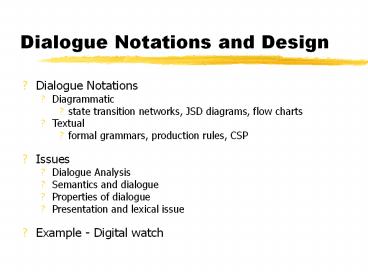Dialogue Notations and Design - PowerPoint PPT Presentation
Title:
Dialogue Notations and Design
Description:
Dialogue Notations and Design. Dialogue Notations. Diagrammatic ... Arc labels a bit cramped because: notation is `state heavy the events require most detail ... – PowerPoint PPT presentation
Number of Views:151
Avg rating:3.0/5.0
Title: Dialogue Notations and Design
1
Dialogue Notations and Design
- Dialogue Notations
- Diagrammatic
- state transition networks, JSD diagrams, flow
charts - Textual
- formal grammars, production rules, CSP
- Issues
- Dialogue Analysis
- Semantics and dialogue
- Properties of dialogue
- Presentation and lexical issue
- Example - Digital watch
2
State transition networks circles states arcs
actions/events
Arc labels a bit cramped because notation is
state heavy the events require most detail
3
Hierarchical STNs managing complex
dialogues named sub-dialogues
4
Flowcharts familiar to programmers boxes
process/event not state
5
JSD diagrams for tree structured dialogues
less expressive greater clarity
6
Concurrent dialogues
7
Concurrent dialogues
8
Concurrent dialogues
9
Textual Grammars Regular expressions sel-line
click click dble-click compare with JSD same
computational model dierent notation BNF expr
empty atom expr (' expr )' expr more
powerful than regular exp. or STNs Still NO
concurrent dialogue
10
Production rules if condition then action Good
for concurrency Event based production
rules Sel-line ! first C-point first !
rest C-point rest ! rest D-point rest ! lt draw
line gt Bad for sequence Bad at state!
11
Prepositional Production System State
based Attributes Mouse f mouse-o, select-line,
click-point, double-click g Line-state f menu,
rst, rest g Rules (feedback not
shown) select-line ! mouse-o rst click-point rst
! mouse-o rest click-point rest
! mouse-o double-click rest ! mouse-o menu Bad at
events!
12
CSP and process algebras used in Alexander's
SPI, and Agent notation good for sequential
dialogues Bold-tog select-bold? ? bold-on ?
select-bold? ? bold-off ? Bold-tog Italic-tog
. . . Under-tog . . . and concurrent
dialogue Dialogue-box Bold-tog Italic-tog
Under-tog but causality unclear
13
Dialogue Notations - Summary
Diagrammatic STN JSD Flow charts Textual gram
mars production rules CSP Issues event base
vs. state based power vs. clarity model vs.
notation sequential vs. concurrent
14
Semantics - Alexander's SPI (i) Two part
specication EventCSP - pure dialogue
order EventISL - target dependent
semantics Centralised dialogue
description Tolerable syntactic/semantic
trade-off
15
Semantics Alexander SPI
EventCSP Login login-mess -gt get-name -gt
Passwd Passwd passwd-mess -gt (invalid -gt Login
valid -gt Session)
EventISL event login-mess prompt true out
Login event get-name uses input set
user-id input event valid uses input,
user-id, passwd-db wgen passwd-id
passwd-db(user-id)
16
Semantics code
17
Action properties completeness missed
arcs unforeseen circumstances determinism severa
l arcs for one action deliberate application
decision accident production rules, nested
escapes consistency same action, same
effect? modes and visibility
18
Checking properties (i) Completeness double-cl
ick in circle states? Reversibility to reverse
select line' from graphics Menu click - double
click - select graphics' (3 actions) N.B. not
undo
19
Checking properties 2
20
State properties reachability can you get
anywhere from anywhere? and how
easily reversibility can you get to the previous
state? but NOT undo dangerous states some
states you don't want to get to
21
Dangerous States
22
Dangerous States 2
23
Lexical Issues
24
Dialogue Analysis - Summary Semantics and
dialogue attaching semantics distributed/central
ised dialogue description maximising syntactic
description Properties of dialogue action
properties completeness, determinism,
consistency state properties reachability,
reversibility, dangerous states Presentation and
lexical issues visibility, style, layout N.B.
not independent of dialogue
25
Digital watch User Instructions
26
Digital watch Designers instructions































